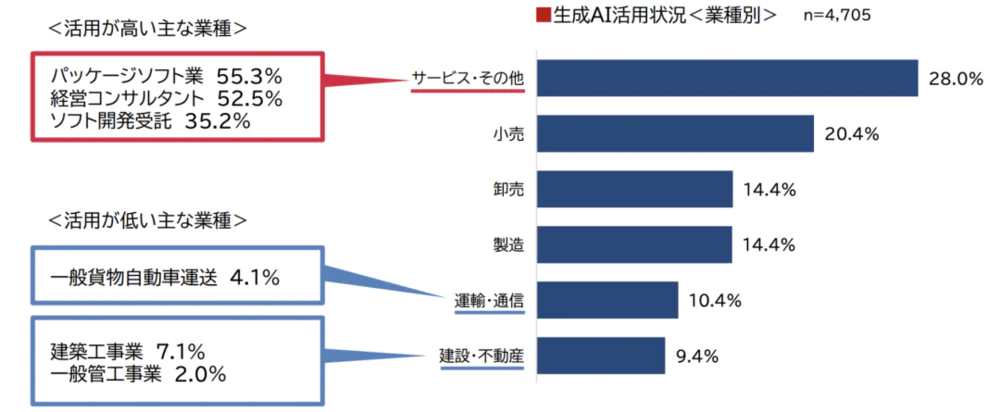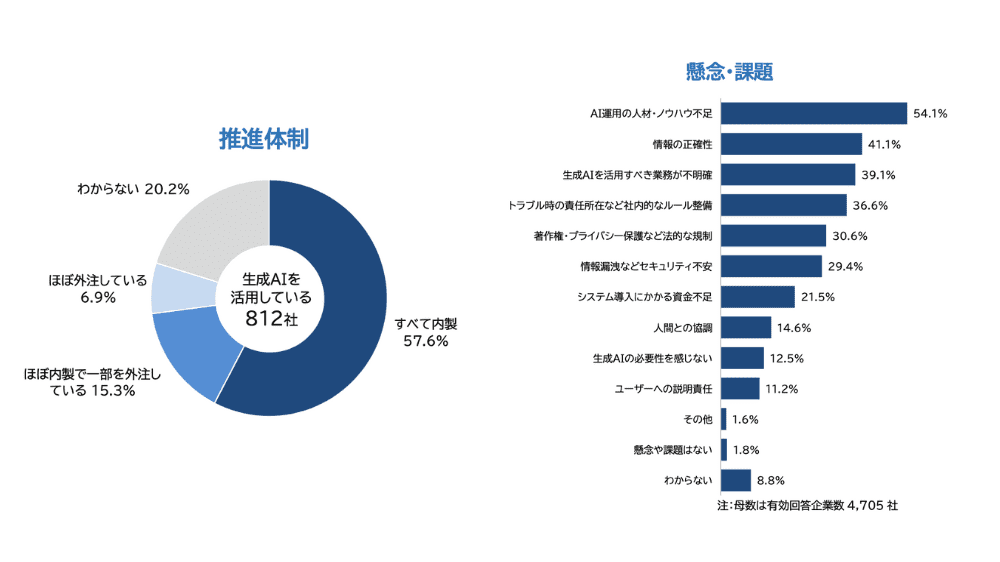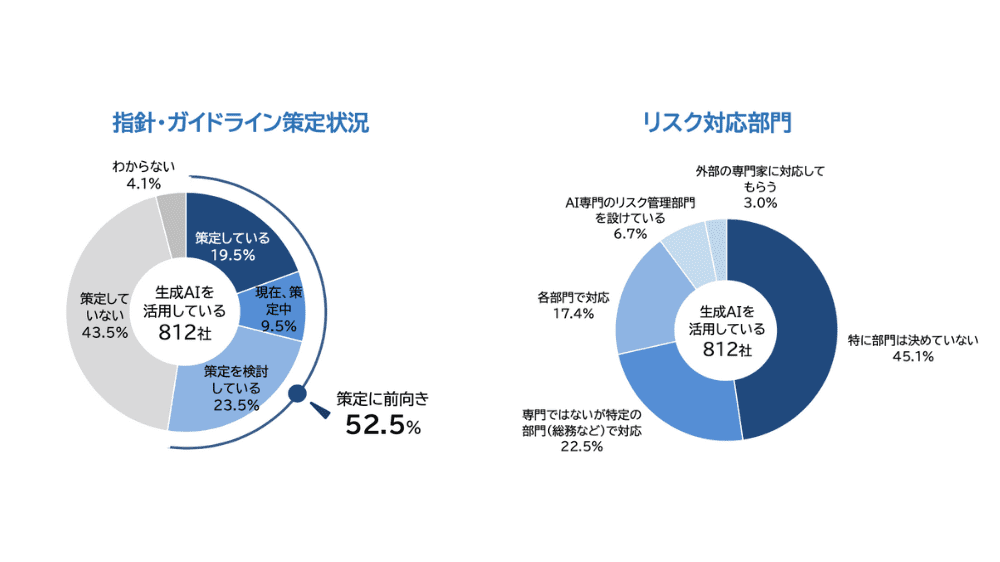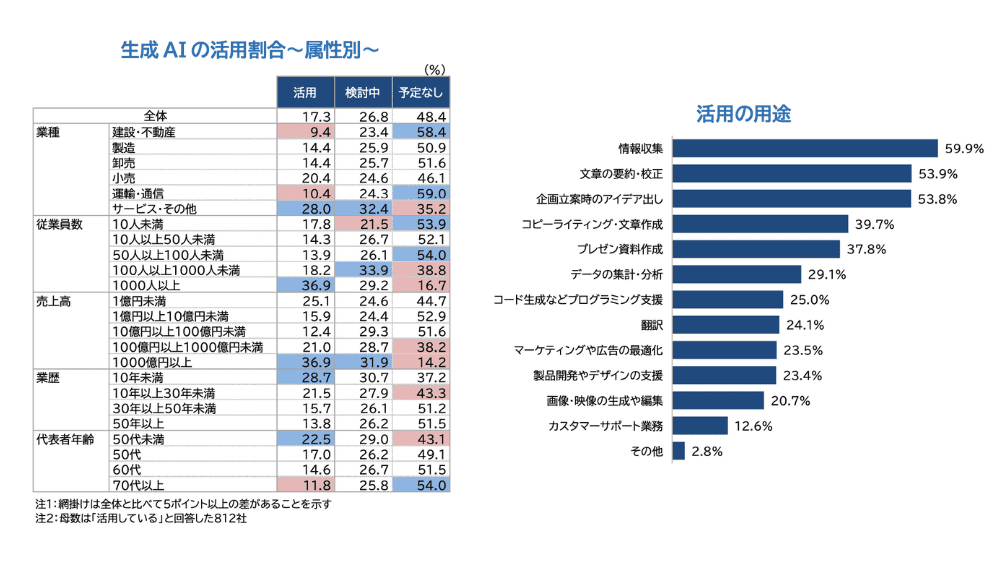The Japanese market for generative AI applications is currently at an early adoption stage, yet it holds significant potential for growth, particularly among small and medium enterprises (SMEs). As AI adoption accelerates, businesses in Japan face both opportunities and challenges in leveraging AI for operational efficiency and revenue growth.
This report examines Japan’s AI application trends, adoption rates, industry-specific usage, major challenges, and potential future directions based on the latest market research and comparative analysis with global AI trends.

1. AI Adoption in Japan: Current State & Trends
(1) Adoption Rate
According to Japan’s TDB survey, approximately 17.3% of businesses in Japan have integrated generative AI into their operations. Among these:
- 86.7% reported positive business impacts, primarily in efficiency improvement and decision-making support.
- 26.8% are actively evaluating AI adoption, indicating strong future growth potential.
- 48.4% of companies have no immediate plans to use AI, signaling that AI adoption remains in its early phase.
Interpretation:
AI adoption in Japan remains relatively low but shows strong growth potential. The main barriers include technological complexity, cost concerns, and limited awareness. However, companies that have implemented AI successfully report substantial benefits, suggesting that AI adoption will increase as successful case studies emerge.
(2) SME Adoption vs. Large Enterprises
- SMEs are adopting AI more rapidly due to their flexibility and short decision-making cycles.
- Large enterprises (1,000+ employees, 100+ billion JPY revenue) have a higher AI usage rate (36.9%) due to greater resources for AI deployment, training, and regulation compliance.
Interpretation:
- SMEs see AI as a way to offset resource constraints, making them early adopters in niche applications.
- Large corporations invest more heavily in AI but move slower due to bureaucratic hurdles and compliance challenges.
- Nearly 50% of businesses remain undecided, highlighting AI’s untapped market potential in Japan.

2. AI Adoption by Industry: Who’s Leading?
The highest AI adoption rates are observed in:
- Service industries (28.0%)
- IT and software development (55.3%)
However, adoption remains low in:
- Traditional manufacturing & construction industries, where AI has limited direct impact on physical operations.
- Industries with limited digital transformation efforts, such as logistics and retail.
Interpretation:
- IT firms naturally have higher AI adoption since they understand and integrate AI tools more easily.
- Manufacturing & construction sectors remain hesitant due to the physical nature of work, requiring more specialized AI solutions.
- AI applications in finance, healthcare, and legal industries remain exploratory, with strict regulations slowing adoption.

3. AI Usage Objectives in Japanese Enterprises
The primary reasons for AI adoption in Japan include:
| AI Use Case | Adoption Rate (%) | Key Benefits |
|---|---|---|
| Improving efficiency | 90.9% | Reducing operational costs, increasing productivity |
| Addressing labor shortages | 44.3% | Japan’s aging workforce requires AI-driven automation |
| Enhancing business capabilities | 32.5% | AI-driven sales & marketing strategies |
Interpretation:
- Efficiency & cost reduction are the main drivers of AI adoption.
- Japan’s labor shortage crisis is accelerating AI interest, as businesses seek automation to compensate for workforce declines.
- AI’s role in business expansion remains secondary, with companies focusing on automation before investing in AI-driven innovation.

4. Key AI Applications in Japan
The most common AI applications among Japanese businesses include:
| Application | Adoption Rate (%) | Use Case |
|---|---|---|
| Information gathering | 59.9% | AI helps in research, competitor analysis, market insights |
| Document summarization & proofreading | 53.9% | AI assists in drafting reports, editing corporate documents |
| Creative inspiration & ideation | 53.8% | AI supports marketing, advertising, and design |
Interpretation:
- AI is primarily used as an efficiency tool, not yet for advanced decision-making.
- Creative industries leverage AI for content generation, but trust in AI for strategic decision-making remains low.
- Future AI growth will depend on increased confidence in AI-generated content and insights.

5. AI Deployment: Internal vs. External Adoption
- 33.5% of businesses limit AI use to specific teams or individuals.
- Only 20.7% of companies have implemented AI company-wide.
- 57.6% rely on internal teams for AI adoption, while only 20% use external AI solutions.
- 46% of firms lack dedicated AI specialists, relying instead on part-time or non-expert employees.
Interpretation:
- AI implementation in Japan remains fragmented, with most companies limiting adoption to specific use cases.
- Companies prefer internal AI teams to manage AI integration, which slows adoption but ensures control.
- The lack of AI specialists is a major bottleneck, with SMEs struggling more due to limited in-house AI expertise.
6. Challenges & Barriers to AI Adoption
The main obstacles preventing wider AI adoption in Japan include:
| Challenge | % of Companies Affected | Details |
|---|---|---|
| Unclear AI use cases | Primary Concern | Many firms do not know how to apply AI to their business |
| High implementation costs | Significant Barrier | AI solutions require substantial initial investment |
| Lack of AI specialists | 54.1% | Many firms lack AI-trained employees |
| Privacy & legal concerns | 30.6% | Copyright, data security, and AI regulation uncertainties |
| Employee resistance | 40.7% | Concerns over AI replacing human creativity & jobs |
Interpretation:
- The biggest AI barrier is a lack of clear use cases, meaning companies need better AI education & training.
- Privacy & security concerns are slowing AI adoption in sensitive industries like finance, healthcare, and legal.
- The talent gap is severe, with most businesses relying on non-experts for AI implementation.
7. Future of AI in Japan: Predictions for 2025 & Beyond
(1) Increased AI Adoption Driven by Labor Shortages
- Japan’s workforce is rapidly aging, forcing companies to adopt AI-driven automation to maintain productivity.
- By 2026, AI is expected to be essential in industries facing severe labor shortages (e.g., healthcare, logistics).
(2) SMEs Will Drive AI Growth
- Large corporations move cautiously due to regulatory concerns, while SMEs innovate faster.
- AI adoption will expand significantly among startups and SMEs, particularly in marketing, e-commerce, and customer service.
(3) AI Regulations Will Shape Market Growth
- Japan’s data privacy laws will determine AI’s future growth.
- Government AI policies & funding will be crucial in helping AI adoption scale.
(4) Expansion of AI-as-a-Service (AIaaS)
- More businesses will outsource AI capabilities to AI service providers.
- AI tools will be integrated into mainstream business software.
Conclusion: AI’s Role in Japan’s Digital Transformation
Japan’s AI adoption is progressing steadily but cautiously. While businesses recognize AI’s potential, costs, talent shortages, and unclear use cases remain key challenges.
Key Takeaways:
- AI adoption remains low (17.3%) but growing rapidly.
- SMEs and IT firms lead in AI use, while traditional industries lag.
- AI is used primarily for efficiency, not yet for high-level decision-making.
- Talent shortages & regulatory concerns hinder adoption.
- Japan’s labor crisis will accelerate AI adoption in 2025-2026.
Japan’s AI market is still evolving, but strong government support and labor shortages will push AI adoption forward in the coming years.
Reference source: https://profab.co.jp/tekoku-databank-ai-survey-2408/

